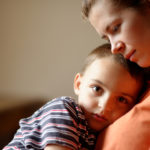This is a paper I missed from 2014, but I think this study adds some important information to the review we posted on topiramate a few weeks ago.
This study collected data from all births recorded in the compulsory Medical Birth Registry of Norway from 1999 to 2011. In all, 2,600 children were exposed to antiepileptic drugs (AEDs) during pregnancy; outcomes in this group were compared to 771,412 unexposed children born to women without epilepsy. Children of mothers with epilepsy but no AED exposure served as an internal control group.
Fetal Growth Restriction: Children exposed to antiepileptic drugs had a moderate risk of growth restriction. This was substantially increased in infants exposed to topiramate (n=90); microcephaly (11.4 vs. 2.4 %; OR 4.8; CI 2.5-9.3) and small for gestational age birth weight (24.4 vs. 8.9 %; OR 3.1; 95 % CI 1.9-5.3) were more common among the topiramate-exposed infants.
Risk of Malformation: Children exposed to carbamazepine (n=783), lamotrigine (n=983), levetiracetam (n=188), oxcarbazepine (n=97), gabapentin (n=39), and pregabalin (n=30) had low malformation rates, whereas children exposed to topiramate tended to have an elevated malformation rate (5/90 or 5.6%). As observed in other studies, valproate monotherapy (n=410) was associated with a significant risk of birth defects (6.3 vs. 2.9 %; OR 2.5; CI 1.6-3.8), and specifically with septal heart defects and hypospadias. For mothers using valproate, the presence of major birth defect in one child was associated with a markedly increased risk for malformation in the siblings (42.9 vs. 6.7 %; OR 10.4; CI 2.3-46.7). Children of untreated mothers with epilepsy had malformation risk similar to the reference group.
The authors noted overall low rates of malformation in infants exposed to monotherapy or polytherapy with the newer antiepileptic drugs; however, the sample size for certain AEDs (e.g., pregabalin, gabapentin) was small. One the other hand, topiramate exposure was associated with an elevated, but not statistically significant, risk of malformation. Interestingly, none of the topiramate-exposed children had oral clefts, a finding which has been observed in precious studies.
More clear was the association between AED exposure and fetal growth restriction; the risk of microcephaly and low birth weight was highest for children exposed to topiramate. Why this association is the greatest with topiramate is not clear. The authors speculate that this finding may be attributable to decreased appetite and weight loss in the mother, which are common side effects of topiramate.
This report, in combination with previous studies suggesting an increased risk of oral clefts in infants exposed to topiramate, urges us to be cautious in the use of topiramate in women who are either pregnant or planning to conceive. While we do not commonly use topiramate to treat psychiatric illness, its use in reproductive age women is rapidly growing. It is now frequently used in women for the prevention of migraine headaches. In addition, topiramate is used to promote weight loss and has been included in the new weight loss drug, Qysmia (a combination of phentermine and topiramate).
Because about half of all pregnancies are unplanned, we must counsel our patients to use effective forms of contraception and we must discuss the potential risks of topiramate use during pregnancy. Prescribers must also be aware that topiramate can reduce the effectiveness of hormonal contraceptives. (This effect is more of an issue with higher doses of topiramate. The starting dosage of Qysmia contains 23 mg of topiramate while the highest dose contains 92 mg.)
The Good News
While this study raises concerns regarding the use of topiramate during pregnancy, other commonly used anticonvulsants, including lamotrigine and carbamazepine, did not increase the risk of fetal growth restriction or congenital malformation.
Ruta Nonacs, MD PhD
Veiby G, Daltveit AK, Engelsen BA, Gilhus NE. Fetal growth restriction and birth defects with newer and older antiepileptic drugs during pregnancy. J Neurol. 2014 Mar;261(3):579-88.








Leave A Comment